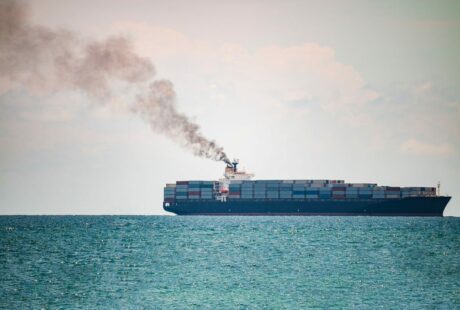During the Golden Age of Sail in the mid-19th Century, Clipper Ships carried cargoes of tea from China to the UK, each one racing to be the first to dock in London to get the advantage over the others during the tea trade season. The reason behind the rush was that the first tea cargo to arrive gave the most profits to tea merchants, so much so that incentives and premiums for the first ships to dock were introduced. This led to events like the famous Great Tea Race of 1866, which spurred a lot of press interest and ended in a very close finish. The story goes that the first two ships to arrive in London from China docked within just 28 minutes apart after spending a whole 99 days (about 3 and a half months) at sea.
This story exemplifies the mindset that has prevailed in the shipping industry and can still be seen today. It can be best described as the practice of “Sail Fast, Then Wait”, meaning ships sail to their destination as fast as safety allows and then wait outside the port until they have a place to dock and unload their cargo. While back in the Tea Race era, fast-sailing ships had a small impact on the environment, today’s need for speed is a key contributing factor to greenhouse gas emissions and other harmful environmental impacts that the maritime transport industry produces.
Nowadays, “Sailing Fast” means that cargo ships have a higher consumption of dirty fuels and, therefore, emit more greenhouse gas emissions than they would normally do if they sailed at slower speeds. It also means an increase in underwater noise pollution as well as a higher risk of collisions with both other ships and animals. Sailing at an increased speed also results in an increase in air pollution around ports. Just to fill you in on some facts, a 20% reduction in ship speed can result in 34% fewer CO2 emissions, a 66% reduction of underwater noise pollution, and a 78% less probability of a fatal whale strike.
If the old saying goes “Sail Fast, Then Wait”, what effect does the latter, which is still an occurrence today, have on the ocean? The average transportation fleet spends 10% of its lifetime waiting outside ports for an available spot. Even though the ships are anchored down, the engines are left running in order to supply power to the ship, and this contributes to noise pollution and dirty fuel emissions. Biofouling, which is the accumulation of waterborne organisms such as algae or barnacles on an underwater structure, grows each day a ship waits in anchorage in warm waters, and if these organisms grow and attach themselves to the hull of a ship, the efficiency decreases and, therefore, more fuel must be consumed. Not great news for the environment.
But why is this old-fashioned practice still very much integrated into the way industry conducts its business today? Why would ship owners still rush to their destination, spending more fuel (and therefore more money), just to wait outside a port, sometimes for weeks on end? In theory, this is baffling but in practice, some of the answers lie behind the contracts and clauses governing the relationships between the ship owners (carriers) and the cargo owners (charters). These contracts are called Charter Party Agreements.
Under most of these Charter Party Agreement contracts, this “Sail Fast, Then Wait” approach is not only encouraged but is also a legal obligation. Ships need to sail at their ‘best speed’ and get to their destination as fast as possible. Not doing so would be a breach of their contractual obligations, something that no ship owner wants to face.
In addition, cargo owners are obliged to pay compensation to ship owners if “laytime” is exceeded. Laytime is a contractual term that defines the time scheduled for the loading and unloading of goods at port. Compensation is due when laytime is exceeded. Just for context, a ship is considered to have “arrived at port” as soon it drops anchor and starts waiting for a free spot, and, depending on the terms and conditions of the contract, this is when laytime starts. Ship owners will purposely speed up their journey to arrive as early as possible so that they can start profiting from any laytime compensation owed to them. However profitable this may be for ship owners, having huge cargo ships waiting at ports with running engines has terrible consequences for the environment.
While the world of contracts in the maritime world is complex and multi-factored, there are some initiatives that are trying to change and all together abolish the “Sail Fast, Then Wait” practice, using the tools of the trade: Legal contracts that already exist.
For example, some international shipping associations offer contract templates and clauses that are widely dispersed in the industry. They have recently introduced new clauses in these contract templates that shift from the “Sail Fast, Then Wait” approach, allowing for a reduction in shipping speed in the interest of reducing carbon emissions. Regulating speed allows ships to arrive at the port when a space is available for them, and therefore waiting times are heavily reduced. More importantly, the new clauses clearly state that “reducing speed does not constitute a breach of the ship owners’ obligations to proceed with due or utmost dispatch and without deviation”. In layman’s terms, this means that, whilst the old contracts obliged the ship owners to sail as fast as possible, new clauses allow ships to slow down without any financial implications.
Some of these contractual amendments are being paired with new, emerging technologies that shift the way the industry thinks about shipping speed. Nowadays, there are technologies that can optimise the arrival time of a group of ships which are all destined for the same port. This is done by anaylsing the individual ship and its surroundings. It organises and optimises its route, and reduces the speed at which it travels, without impacting its commercial performance as each ship arrives at the time expected, but with the difference that there is no waiting time at the port.
Like the old Tea Races, the “Sail Fast, Then Wait” approach should be condemned to the history books, along with fond memories of the golden age of sailing. It has no place in today’s world with today’s technologies. It has been proven, time and time again, that reducing shipping speed and increasing the efficiency of a cargo ship’s voyage has a number of social and planetary advantages. It will help reduce emissions, which is top priority if we are to keep within the 1.5c global heating limit, as well as reduce underwater noise pollution, will limit whale strikes, and lead to a just transition, to name just a few examples. Even though the scientific evidence speaks volumes, it seems that contracts and specific clauses must be introduced to force the shipping industry to behave and comply with what seems like an obvious solution to climate change.
We have the means, and we have the technology to really make a positive change in the shipping industry. If there is one race to be won, it is the race towards a sustainable and healthy planet.
Posted on: 1 June 2023



